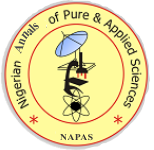Determination of Natural Radioactivity in Nuts and Seeds and their Radiological Implications in the Human Body
DOI:
Keywords:
Natural radioactivity, Radiological hazards, Nuts, Seeds, Annual effective doseAbstract
Naturally occurring radionuclides in nuts and seeds commonly consumed in Windhoek, Namibia were examined. This was done by measuring the activity concentrations of 40K, 226Ra, and 232Th in these nuts and seeds resulting in the determination of their associated radiological hazards. Ten samples of nuts and seeds of different species were purchased from shop outlets around Windhoek and a gamma ray spectrometer was used to determine their activity levels. The average activity concentration of the radionuclides 40K and 226Ra were found to be 101.295.55 Bq/kg and 0.80 0.35 Bq/kg respectively, 226Ra was only found in some samples. 40K was found to be very high in most of the samples with the maximum specific activity of 122.22Bq/kg in almond nuts. The maximum specific activity of 226Ra was found to be 4.19 Bq/kg in cashew nuts. However, this did not exceed the permissible limit. The specific activity of 232Th was Below Detection Limit (BDL) in all the samples. The annual effective dose equivalent in all samples was found to be below the limit of 1mSvy-1. All the radiological assessments made in this study showed that there were no radiological risks associated with the ingestion of nuts and seeds sold in Namibia.
Downloads
Published
How to Cite
Issue
Section
License
Copyright (c) 2022 S. A. Onjefu, N. P. Wilika, M. Hitila, C. Kamunda, R. H. Hamunyela, S. O. Asuquo, E Ejembi, M. K. Mutorwa, H. H. Euodia

This work is licensed under a Creative Commons Attribution-ShareAlike 4.0 International License.



 Contact Us
Contact Us Editorial Team
Editorial Team Join As A Reviewer
Join As A Reviewer  Request For Print Copy
Request For Print Copy


 Cprint Publishers
Cprint Publishers